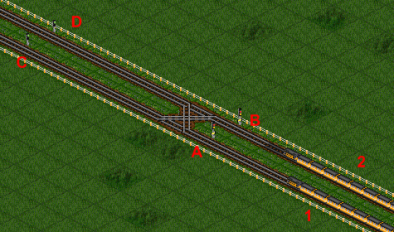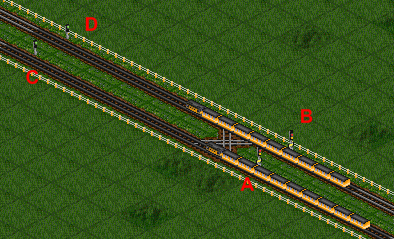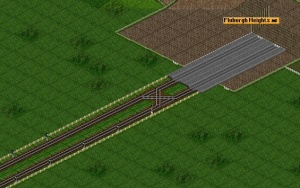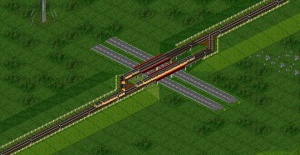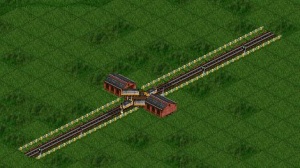PBS
From #openttdcoop wiki
Contents
Description
PBS stand for Path Based Signaling, which is a different way of signaling trains when they can enter a certain track segment. Although primarily intended in OpenTDD (and in the real world) to provide bi-directional track, without the deadlocks that will occur with regular signaling. Besides that it can also be used to increase performance in certain situations.
At the time of writing, a new implementation of PBS has made its way into the development branch of OpenTTD and might thus be encountered on the #OpenTTDCoop server. The implementation, named YAPP, adds two additional signals. Because PBS takes some getting used to we've collected some examples and hints to work with.
How it works
For an explanation on the basics of YAPP and some examples, please check the YAPP page on the OpenTTD site.
In short: PBS introduces a new type of signal, which comes in two flavors. The first type is a regular PBS signal, the second a one-way PBS signal. When a train encounters a PBS signal it will attempt to reserve a path. This means that it will look ahead at the path it wants to go and determines whether there are any obstacles in the way, such as another train. It will only look as far as the next signal it encounters (any signal, no specific type). When a reservation can be made, the train will go past the signal along the reserved path, otherwise it'll wait until it can do so.
The advantage of PBS is that it allows multiple trains to enter a PBS guarded area, as long as their reserved paths do not cross each other. While a regular signal would stop the second train until the entire section of track is clear, using PBS signaling trains can overcome this limitation. An example can be shown below. Here, both trains will attempt to enter the crossing, both trains go straight ahead on their path. When the first train encounters PBS signal A, it will reserve a path up to signal C. Since there are no obstacles, the reservation is allowed and the train passes. Moments later, the second train encounters signal B and attempts to reserve a path to signal D. Since train 1 is not in the way, the reservation will be made as well and train 2 will continue as well. At that time, both trains are in the same PBS signaled section. If regular signals would be used in this case, one train would always have to wait.
Examples from #OpenTTDCoop games
Terminus station
This is a normal terminus station, except that PBS is used to allow more than one train to be in the signaling block in front of the station. The entry has a one-way PBS signal, each station track has a normal PBS signal facing the station. The exit has a regular one-way exit signal. The advantage of the station shown in the screenshot is that it allows a train to leave the station while another train enter it. This could improve throughput, depending on how large your station is. Please note that the exit signal has a gap, to avoid that a train waiting in front of that signal will block the track.
PBS bridges
The bridges shown here have only one signal placed in front of them, with regular signals after them. As you can see from the screenshot, there is very little track in front of the bridge, because there are no signals needed in front of the bridge.
PBS depot
This depot setup slightly improves the amount of trains that can be serviced. It basically allows for two trains to be on the same tile, for example to have one train exit the depot while the other enters it.
Hints for using PBS
- Enable 'Show reserved tracks' in the OpenTTD patches to show ingame which tracks are being taken by trains entering sections. In the screenshots above you can see this, the track is a little darker.
- A train can stop at any signal, it's important to avoid that a train can block important track. An example is the terminus station, where the exit is built a few tiles away. Should you build the exit signal on the first exit tile, chances are that the train leaving the station has to stop for something and blocks several tracks. Guideline is to build the signal far enough to have your trains fit into the section between the switch tiles and the signal.
